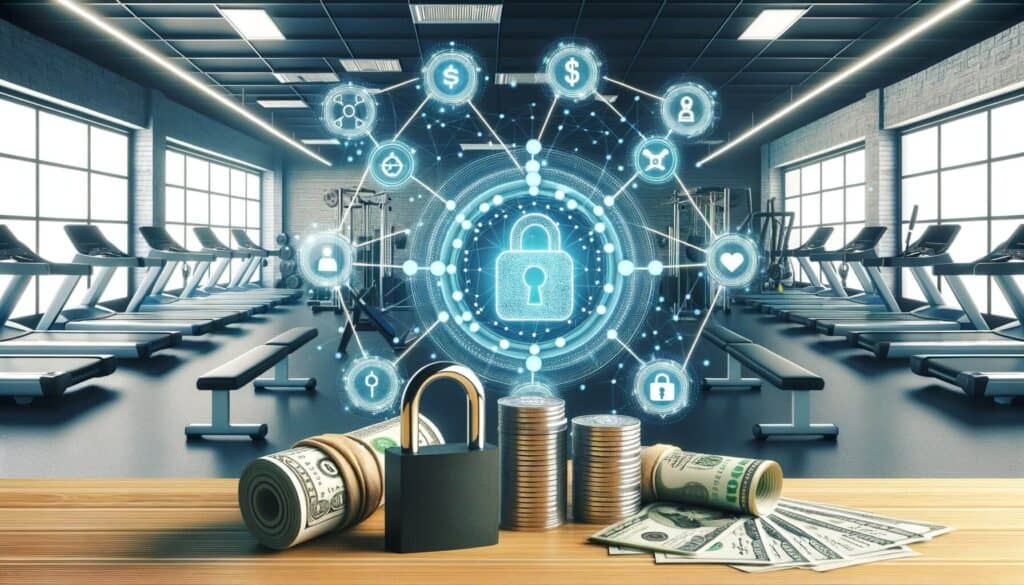
By Amelie Bowen April 14, 2025
In recent years, the world has witnessed a significant rise in the popularity of cryptocurrencies and decentralized finance (DeFi). These innovative technologies have revolutionized various industries, and the fitness industry is no exception. DeFi payment systems have emerged as a game-changer for fitness centers and gyms, offering a secure, efficient, and transparent way to handle membership fees and other services.
Understanding Decentralized Finance (DeFi) and its Impact on the Fitness Industry

Decentralized finance, or DeFi, refers to the use of blockchain technology and cryptocurrencies to recreate traditional financial systems in a decentralized manner. Unlike traditional finance, which relies on intermediaries such as banks, DeFi operates on a peer-to-peer network, eliminating the need for intermediaries and reducing costs.
The impact of DeFi on the fitness industry is profound. Fitness centers and gyms often face challenges in managing payments, memberships, and services. Traditional payment systems can be cumbersome, slow, and prone to fraud. DeFi payment systems offer a solution by leveraging the benefits of blockchain technology, such as transparency, security, and efficiency.
Benefits of DeFi Payment Systems for Fitness Centers and Gyms

1. Transparency: DeFi payment systems provide a transparent record of transactions on the blockchain, allowing fitness centers and gyms to easily track and verify payments. This transparency reduces the risk of fraud and improves trust between the facility and its members.
2. Efficiency: Traditional payment systems often involve multiple intermediaries, resulting in delays and higher costs. DeFi payment systems eliminate these intermediaries, enabling instant and low-cost transactions. This efficiency benefits both the fitness center and its members.
3. Global Accessibility: DeFi payment systems are not limited by geographical boundaries or traditional banking hours. Fitness centers can accept payments from members around the world, expanding their customer base and revenue streams.
4. Lower Fees: DeFi payment systems typically have lower transaction fees compared to traditional payment systems. This cost-saving benefit allows fitness centers to allocate more resources to improving their facilities and services.
5. Security: Blockchain technology, the foundation of DeFi payment systems, offers robust security features. Transactions are encrypted and stored across a decentralized network, making it extremely difficult for hackers to manipulate or steal sensitive information.
Exploring the Use Cases of Cryptocurrency in Fitness Membership and Services

The use cases of cryptocurrency in fitness membership and services are diverse and innovative. Here are some examples:
1. Membership Payments: Fitness centers can accept cryptocurrency as a form of payment for membership fees. This provides members with an alternative payment option and allows them to take advantage of the benefits of using cryptocurrencies, such as faster transactions and lower fees.
2. Personal Training Services: Cryptocurrencies can be used to pay for personal training sessions or other specialized services offered by fitness centers. This eliminates the need for cash or credit card transactions, streamlining the payment process for both the facility and the client.
3. Loyalty Programs: Fitness centers can create their own cryptocurrency or token and reward members for their loyalty. These tokens can be redeemed for discounts on membership fees, merchandise, or other services, incentivizing members to stay committed to their fitness goals.
4. Equipment Purchases: Cryptocurrencies can be used to purchase fitness equipment, either directly from manufacturers or through online marketplaces. This provides fitness centers with a convenient and secure way to upgrade their equipment while also supporting the growth of the cryptocurrency ecosystem.
How DeFi Payment Solutions Enhance Security and Privacy in the Fitness Industry

Security and privacy are paramount concerns in the fitness industry, as members often share personal and financial information with fitness centers. DeFi payment solutions address these concerns in the following ways:
1. Encryption: DeFi payment systems use advanced encryption algorithms to secure transactions and protect sensitive information. This ensures that member data remains confidential and cannot be accessed by unauthorized individuals.
2. Decentralization: DeFi payment systems operate on a decentralized network, meaning that transactions are not stored in a single location. This makes it extremely difficult for hackers to breach the system and compromise member data.
3. Anonymity: Cryptocurrencies offer a certain level of anonymity, as transactions are recorded on the blockchain without revealing the identities of the parties involved. This protects the privacy of fitness center members, who may prefer to keep their financial information private.
4. Smart Contracts: DeFi payment systems often utilize smart contracts, which are self-executing contracts with the terms of the agreement directly written into code. Smart contracts eliminate the need for intermediaries and ensure that payments are automatically processed once the conditions are met, reducing the risk of human error or fraud.
Overcoming Challenges and Adoption Barriers of DeFi Payment in Fitness
While DeFi payment systems offer numerous benefits to the fitness industry, there are still challenges and adoption barriers that need to be addressed:
1. Education and Awareness: Many fitness center owners and members may not be familiar with cryptocurrencies or DeFi payment systems. Education and awareness campaigns are crucial to help them understand the benefits and overcome any misconceptions or concerns.
2. Regulatory Environment: The regulatory landscape surrounding cryptocurrencies and DeFi is still evolving. Fitness centers need to navigate these regulations to ensure compliance and build trust with their members.
3. Volatility: Cryptocurrencies are known for their price volatility, which can pose a challenge for fitness centers that accept them as payment. Implementing strategies to mitigate this risk, such as converting cryptocurrencies to stablecoins or fiat currencies immediately, can help address this challenge.
4. Integration with Existing Systems: Fitness centers may already have established payment systems in place, making it challenging to integrate DeFi payment solutions seamlessly. Collaboration with technology providers and thorough testing can help overcome this barrier.
Step-by-Step Guide: How to Implement DeFi Payment Systems in Fitness Centers
Implementing DeFi payment systems in fitness centers requires careful planning and execution. Here is a step-by-step guide to help fitness center owners navigate the process:
1. Research and Select a DeFi Payment Platform: Start by researching different DeFi payment platforms that cater to the fitness industry. Consider factors such as security features, user experience, and integration capabilities. Select a platform that aligns with your specific needs and goals.
2. Develop a Payment Strategy: Determine how you want to incorporate DeFi payment systems into your existing payment infrastructure. Consider factors such as membership fees, personal training services, and loyalty programs. Define the cryptocurrencies you will accept and establish conversion processes if necessary.
3. Educate Staff and Members: Provide training and educational resources to your staff and members to familiarize them with cryptocurrencies and DeFi payment systems. Address any concerns or questions they may have and emphasize the benefits of using these systems.
4. Update Policies and Procedures: Review and update your policies and procedures to reflect the integration of DeFi payment systems. Ensure that your terms and conditions are clear and transparent, addressing issues such as refunds, cancellations, and dispute resolution.
5. Test and Implement: Before fully implementing DeFi payment systems, conduct thorough testing to ensure seamless integration with your existing systems. Test different scenarios, such as membership sign-ups, payments, and refunds, to identify and address any potential issues.
6. Monitor and Evaluate: Once the DeFi payment systems are implemented, closely monitor their performance and gather feedback from staff and members. Continuously evaluate the effectiveness of these systems and make necessary adjustments to improve the user experience.
Comparison of Popular DeFi Payment Platforms for Fitness Membership and Services
Several DeFi payment platforms cater specifically to the fitness industry. Here is a comparison of some popular platforms:
1. FitPay: FitPay offers a comprehensive payment solution for fitness centers, allowing them to accept cryptocurrencies such as Bitcoin and Ethereum. The platform provides a user-friendly interface and integrates seamlessly with existing systems.
2. GymCoin: GymCoin is a cryptocurrency designed specifically for the fitness industry. It enables fitness centers to create loyalty programs, accept payments, and reward members for their engagement. GymCoin also offers a mobile app for easy access and management.
3. MyFitCoin: MyFitCoin is another cryptocurrency tailored for the fitness industry. It allows fitness centers to accept payments, track member activity, and offer rewards. MyFitCoin also provides a marketplace where members can purchase fitness-related products and services.
4. ZenSports: While not exclusively focused on the fitness industry, ZenSports offers a decentralized sports betting platform that can be utilized by fitness centers. This platform allows fitness centers to accept cryptocurrency payments for sports-related services and events.
Frequently Asked Questions (FAQs) about DeFi Payment in Fitness
Q1: What is the difference between DeFi payment systems and traditional payment systems?
A1: DeFi payment systems operate on a decentralized network, eliminating the need for intermediaries and reducing costs. Traditional payment systems rely on banks and other intermediaries, resulting in slower transactions and higher fees.
Q2: Are DeFi payment systems secure?
A2: Yes, DeFi payment systems leverage blockchain technology, which offers robust security features. Transactions are encrypted and stored across a decentralized network, making it extremely difficult for hackers to manipulate or steal sensitive information.
Q3: Can fitness centers accept any cryptocurrency as payment?
A3: Fitness centers can choose which cryptocurrencies they accept as payment. However, it is important to consider factors such as liquidity, stability, and compatibility with existing systems.
Q4: How can fitness centers mitigate the risk of cryptocurrency price volatility?
A4: Fitness centers can mitigate the risk of cryptocurrency price volatility by converting cryptocurrencies to stablecoins or fiat currencies immediately after receiving them. This helps ensure that the value of the payment remains stable.
Q5: What are the benefits of loyalty programs using cryptocurrencies?
A5: Loyalty programs using cryptocurrencies offer several benefits, such as increased customer engagement, improved customer retention, and the ability to reward members with unique and valuable incentives.
Conclusion
DeFi payment systems have the potential to revolutionize the fitness industry by offering secure, efficient, and transparent payment solutions. Fitness centers and gyms can benefit from the transparency, efficiency, and global accessibility of DeFi payment systems. By embracing these innovative technologies, fitness centers can enhance security and privacy, overcome challenges and adoption barriers, and provide a seamless payment experience for their members. As the world continues to embrace cryptocurrencies and decentralized finance, the integration of DeFi payment systems in the fitness industry is poised to become the new norm.